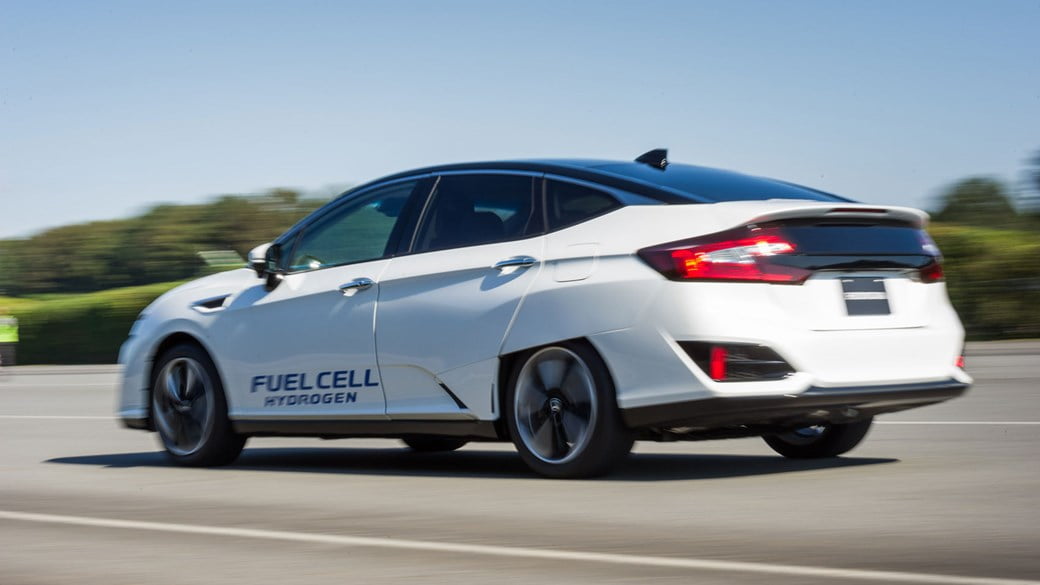The fuel cell car continues to polarise the automotive world. The pro lobby sees them as the long-range personal transport solution of a hydrogen-based society, holding a glass to their exhaust pipe and smugly drinking the car’s waste output as proof of its green credentials. Critics laugh at the wastefulness of using (lots of) electricity to create the necessary hydrogen, only to then stick it in a car that turns it back to electricity for motive power – why not just run the car on electricity alone, and forget the hydrogen? Because of range, and the fact that, like a petrol or diesel car, one powered by a fuel cell can be ready to go again (for 430 miles or more in this case) in moments.
The last-gen Clarity was a very low-volume toe in the water for Honda – just 72 were built. The new one, boasting an energy density improvement of 33%, will be leased in Japan in the near future. It’ll arrive in limited numbers in the UK late in 2016. Price is yet to be set but expect little change from £50-60k.
 Next to a Mirai it looks almost handsome…
Next to a Mirai it looks almost handsome…
Faint praise perhaps, but the Clarity is a nicely resolved design. Where Toyota went all out to communicate Mirai’s newness through its avant-garde styling, Honda has played things a little more coolly with Clarity, and successfully so. It’s equally agreeable inside, with space enough for five and acres of rear legroom (as you’d expect of a car just short of five metres long), a McLaren style ‘floating’ centre console and a dashboard design that deftly blends futuristic and tasteful. The boot’s ‘big enough for three golf bags’ and a glazed bootlid means rear visibility is good despite the elevated rump.
Click here to read CAR’s Toyota Mirai review.
It does look a little heavy around the hips…
That’ll be the vast main hydrogen storage tank, which sits above the rear wheels, sandwiched between the rear seats and the boot. The gas is stored at tremendous pressure, 700 bar, and to deliver the necessary capacity, around 5kg of hydrogen, the Clarity uses a vast main tank and a second smaller one under the rear floor. Both are made of carbonfibre and lined in aluminium. They’re hugely expensive – the cost of these tanks is the main reason fuel cell cars are so pricey – and Honda is working with GM to try to develop a more affordable, mass-produced fuel cell powertrain, the fruits of which are expected by 2020.
Fuel cell under the bonnet then?
Indeed. By reducing its size and laying the motor unit down, Honda has managed to get the stack, motor and single-speed transmission into what would normally be the engine bay. A modest lithium ion battery under the floor helps out on start up and acts as a buffer between the cell and the motor, ensuring there’s always power on demand.
Silent, quick-ish and refined
Like any good EV, a drive in the FCV is as good as a massage for relaxation and the banishment of stress. The powertrain is slick, pretty quick if you select Sport mode – on a fuel cell car, really? – and almost completely silent, the only noise a little muted tyre roar and the distant hum of the turbo compressor as it works to keep the fuel cell stack in compressed air. Factor in the light, airy and very comfortable cockpit and the Clarity feels less like some rough and ready pioneering prototype and more like a luxury car. Just as well, given the price.
Those seeking driver satisfaction should look elsewhere, obviously. The Clarity is long, pretty heavy (around 1800kg) and set up for comfort not speed. There’s pronounced body roll, largely inert steering and a general disinterest in corner speed, as you’d expect. Nevertheless this is a nice car to drive – a next-gen cruiser in which the motorway miles would fly by.
Verdict
The car is good, very good, but as ever with fuel cell machines the car is not the issue. Current estimates put the UK network at three stations, all in the south. Next year there’ll be seven. But Honda, together with others, is committed to creating a proper network, and by 2018 it expects a chain of 65 stations.
For now though, where you live dictates your suitability for Clarity ownership – that and your willingness to accept lacklustre performance compared to a similarly priced diesel or petrol luxury saloon. In return you’ll be compensated in near-silent refinement and the knowledge you’re not (directly) adding yet more CO2 to the atmosphere.
[“source-carmagazine”]




 Next to a Mirai it looks almost handsome…
Next to a Mirai it looks almost handsome…